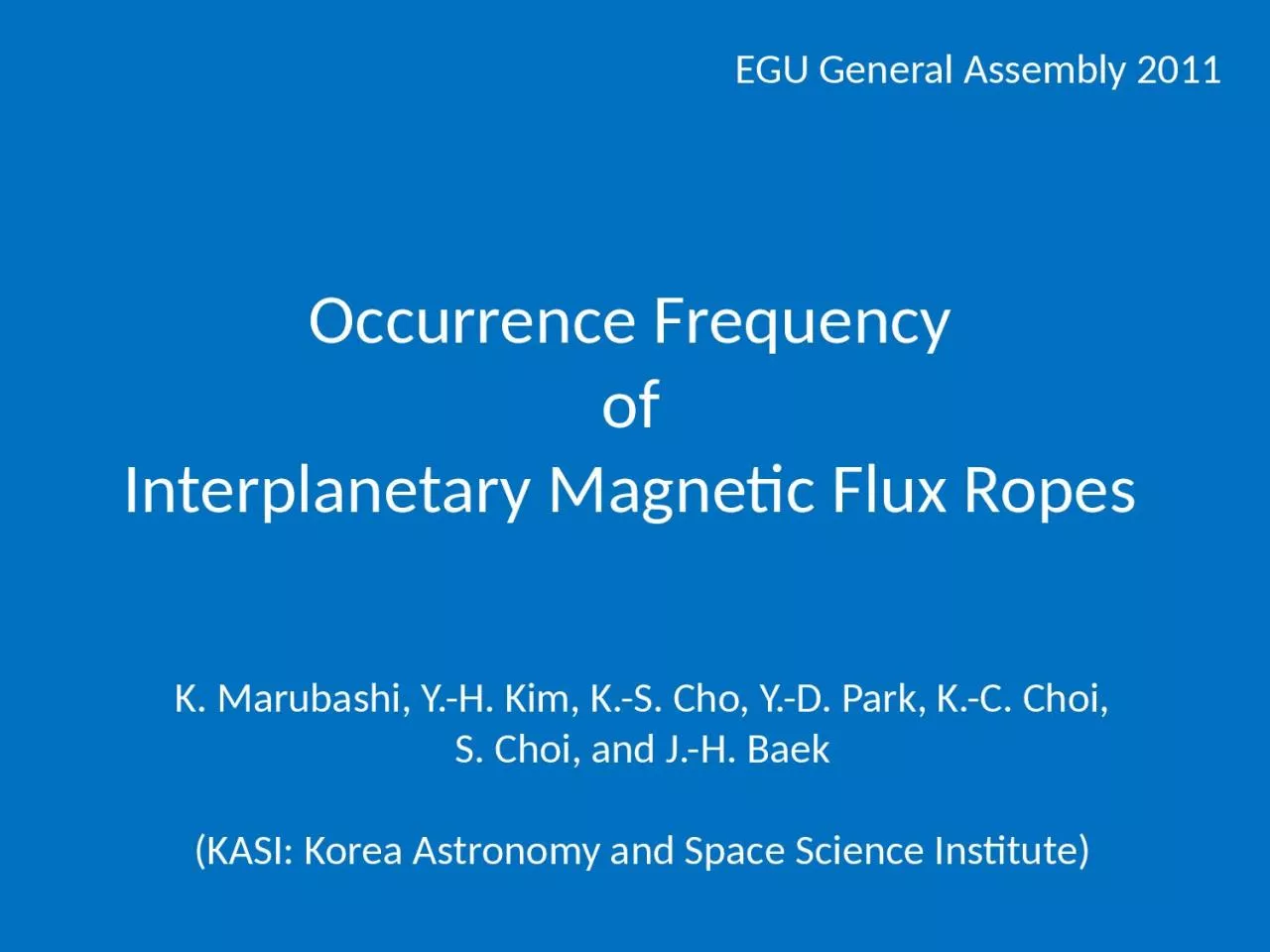

Occurrence Frequency of Interplanetary Magnetic Flux Ropes K Marubashi YH Kim KS Cho YD Park KC Choi S Choi and JH Baek KASI Korea Astronomy and Space Science Institute ID: 1020593
Download Presentation The PPT/PDF document "EGU General Assembly 2011" is the property of its rightful owner. Permission is granted to download and print the materials on this web site for personal, non-commercial use only, and to display it on your personal computer provided you do not modify the materials and that you retain all copyright notices contained in the materials. By downloading content from our website, you accept the terms of this agreement.
1. EGU General Assembly 2011Occurrence FrequencyofInterplanetary Magnetic Flux RopesK. Marubashi, Y.-H. Kim, K.-S. Cho, Y.-D. Park, K.-C. Choi,S. Choi, and J.-H. Baek(KASI: Korea Astronomy and Space Science Institute)
2. OUTLINEWe searched for magnetic field structures which can be well fitted to the force-free flux rope models, in the solar wind data from WIND/ACE (1995 – 2009).The most important finding is: “The number of such structures is far, far, far more than those implied by previous surveys.”Why it happened? How it is possible? Identification of large impact parameter events Events that can be explained only by torus model
3. Lepping et al. (2006) Occurrence frequency: very low MCs and MC-like structures: follow the change of SSN.Previous MC SurveysKlein & Burlaga (1982)Zhang & Burlaga (1988)Lepping et al. (1990)Bothmer & Schwenn (1998)Marubashi (2000)Lynch et al. (2005)Huttunen et al. (2005)Lepping et al. (2006) ------- -------
4. Present Result: Year-to-year variation of occurrence number (Conditions: Duration >= 7 hours, Erms < 0.35)toruscylinder(some part: torus) Occurrence : (1) much higher than hitherto believed (2) yearly change in parallel to solar activityCYLINDER, CYLINDER & TORUS: 440
5. Two mathematical models (cylinder & torus)S/C passing near the apex:Local Structure can be approximated by a cylinder shown by dashed line. S/C passing near the flank:Curvature effects should be taken intoaccount, and the simplest approximationIs given by a torus geometry.Torus model: to describe local geometry, not indicating the wholestructure were torusCylinder modelTorus model
6. An example: Only “torus model” can reproduce the observations (Duration = 43 hours, Rotation of the filed = 330 deg)
7. Statistical Distribution of “cylinder parameters”(Conditions: Duration >= 7, Erms < 0.35, Cone angle < 10) Finding: Occurrence increases with impact parameter. Note: Circled portions need further consideration.
8. Further Selection (Exclude extreme cases)1. Impact parameter (p): |p| < 0.98 Geometries may not be reliable. This condition excludes many events of R > 0.2 AU.2. Duration (Td): Td < 30 hours Many of long-duration events are better fitted to torus model.3. Cone Angle (Ac): Ac > 10 degrees (already adopted) Small Ac events need torus-fitting. This condition excludes many events of small R.(Note: Criteria for p, Td, Ac need further consideration.)
9. Statistical Distribution of Cylinder Parameters(Modified: |p| < 0.98, Td < 30 hrs, Ac > 10 deg) excludedmostly excludedmostly excludedIncrease with |p|: main reason for the large occurrence
10. Lepping and Wu (2010): occurrence vs. Impact ParameterWe need to admit that only small I.P. cases were studied so far.(They are easy to identify due to large angle rotation of B vector)
11. Possible|p|dependence of detected event number p (dark blue) < p (light blue) Cylinder axes correspond to tangent lines to 2 circles.Consider in 2-D (YZ-plane): If angular distributin is uniform, number is propotional to r (p).
12. Distribution of the cylinder axis direction (Lat. & Long.)N = 325(to Sun)
13. Distribution of Cone Angles 7 hrs =< Td < 30 hrs |p| < 0.98 Cone angle > 10 degIf the axis orientation is uniformly distributed, theevent numbers should be constant in this diagram.At cone angles 20~75, it looks to be satisfied.
14. Most probable distribution of MC cylinder radii (241 events: 20 deg =< Cone angle < 75 deg)We expect a similar radius distribution for torus events.
15. Concluding Remarks1. We could identify ~ 500 flux rope structures in the solar wind data of 1995 -2009, their occurrence frequency changes with sunspot activity. (much, much larger number)2. The flux rope detection rate increases with the impact parameter, in agreement with simple geometrical consideration.We are preparing a website to provide all the fitting results.
16. Thank youforyour attention!